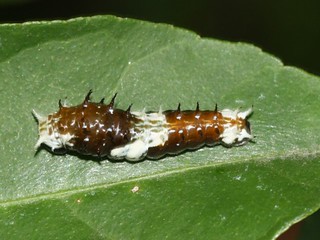 |
Firefly larva © Corey Kallstrom
|
 |
Glowworm (Phengodes sp.) © Ashley Bradford
|
Lightning bug larvae have green lights
along their bodies. They look like little trains, and that is what we
call them in Argentina, trencitos. One wonders about the purpose of
these lights. Adults use theirs to attract members of the opposite
sex, but larvae have nothing to do with that. These lights must serve
another purpose. It turns out that lightning bugs are highly toxic and
bad tasting, so the lights are telling predators to stay away and avoid the unpleasantness.
 |
| Monarch caterpillar
© Beatriz
Moisset
|
 |
Eastern
swallowtail butterfly caterpillar.
Showing its
osmateria when threatened
©
Beatriz Moisset
|
 |
Caterpillar
and some of its refuse
or frass
©
Beatriz Moisset
|
 |
Larval
tunnels on wood (possibly
a beetle)
filled
with frass
©
Beatriz Moisset
|
At the other end of the spectrum, there
are larvae whose mothers have provided with a rich, highly nutritious food.
Many wasps and bees do that. In the case of wasps, the food is
insects or spiders; bees, on the other hand, collect pollen and
nectar for their brood. These larvae live in splendid isolation
inside small compartments, called cells, built by their mothers. The
amount of food supplied is slightly larger than the future adult bee
or wasp. Almost all of it is converted into flesh and nothing is
wasted. At the end of the larval stage, only a
small pellet of fecal matter is produced. It gets the name of
meconium, comparable to the first bowel movement of a newborn baby.
The baby's meconium is the accumulated waste of a few months; so the
similarity is strong.
 |
Cell of
Crabronid wasp larva (Trypoxylon
collinum)
Opened cell
reveals the fully grown larva and the pellet of meconium (left)
No remains of
the spiders that fed this larva
©
Beatriz Moisset
|
 |
Golden tortoise beetle
larva carrying its feces
©
Beatriz Moisset
|
Beginners Guide to Pollinators and Other Flower Visitors
© Beatriz Moisset. 2017
















